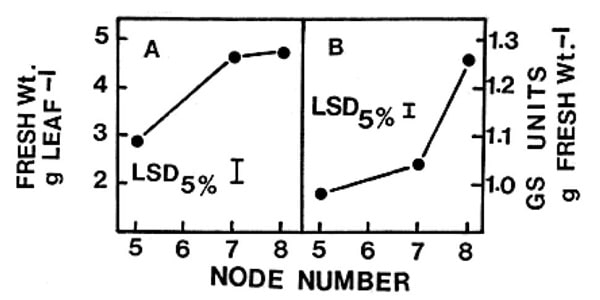Cucurbit Genetics Cooperative Report 6:25-26 (article 13) 1983
D. M. Pharr, T. C. Wehner, L. W. Handley, and H. N. Sox
North Carolina State University, Raleigh, NC 27650
Galactinol synthase (GS) catalizes the following reaction in cucumber leaves:
UDP-galactose + myoinositol galactinol + UDP
Galactinol is the immediate substrate from which galactose is transferred to sucrose to form raffinose, and a second galactose is transferred from galactinol to raffinose to form stachyose. Raffinose and stachyose are the major sugars transported by cucumbers, although sucrose may also be transported. Recent studies have shown that leaves of different species have widely varying levels of GS activity (1). More importantly, the level of activity of this enzyme was positively correlated (r = +0.84) with the concentration of raffinose saccharides in the leaves and negatively correlated (r = -0.73) with leaf sucrose. Thus, GS activity may control carbon partitioning between sucrose and the raffinose saccharides in leaves.
The objectives of the present study were to determine the levels of activity of GS in leaves of five diverse lines of Cucumis sativus.
Five cultivars of lines of cucumber (‘Windermoor Wonder’, ‘Calypso’, ‘Sumter’, PI 228238, and LJ 90430) were planted in the greenhouse in a randomized complete block design with 3 replications in early August, 1982. All of the lines. tested were Cucumis sativus var. sativus except LJ 90430, which is var. hardwickii. All plants were maintained in a vegetative condition by removal of all flower buds as they appeared. Plants were trained to a single main stem by removal of all lateral buds as they appeared. When the plants had grown to an average of 12 nodes, leaf blades were removed from the 5th, 7th, and 8th nodes from the growing terminal (,counting down from the youngest leaf). Fresh weights were recorded, and GS activity was determined on these samples essentially by procedures described elsewhere (1, 2).
Mean fresh weights of leaves at the 3 node positions and GS activity of these leaves are shown in Fig. 1. The activity of the enzyme increased as leaves expanded, which confirms other unpublished data from our laboratory.

Figure 1. (A) Fresh weight of leaves from nodes 5, 7 and 8. (B) GS activity in leaves from 5, 7 and 8. Data are means of 3 replications and 5 lines of Cucumis sativus.
Variability among lines was significant only at the 10% level (Table 1). This variation is small by way of comparison to variability between different plant species which have been shown to vary from 0 to as high as 2.5 units of GS per gram fresh weight of leaves (1).
The five lines studied here were selected to represent a maximum range in leaf GS activity identified from a preliminary study (data not shown) in which 13 different lines were assayed. Based on these tentative results, identification of Cucumis sativus lines varying widely in leaf GS level and the presumed differences in leaf sugar composition which might be associated, will probably be achieved only be screening large populations.
Table 1. Cucumis sativus lines in order by mean galactinol synthase (GS), activity in their leaf blades.z
Cultivar or Line |
GS Activityy Units/gram fresh weight |
| Windermoor Wonder | 1.23 |
| PI 233238 | 1.22 |
| LJ 90430 | 1.07 |
| Calypso | 1.06 |
| Sumter | 0.90 |
| LSD (10%) | 0.22 |
zData are means over 3 node positions and 3 replications of 2 subsamples each. There was no line x node interaction.
yA unit is that amount of enzyme which forms 1 mol of galactinol min-1 at 30°C.
Literature Cited
- Handley, L. W. 1983. The role of galactinol synthase in the biosynthesis of raffinose saccharides. Ph.D. Thesis. North Carolina State University, Raleigh.
- Pharr, D. M., H. N. Sox, R. D. Locy and S. C. Huber, 1981. Partial characterization of the galactinol forming enzyme from the leaves of Cucumis sativus L. Plant Science Letters 23:25–33.